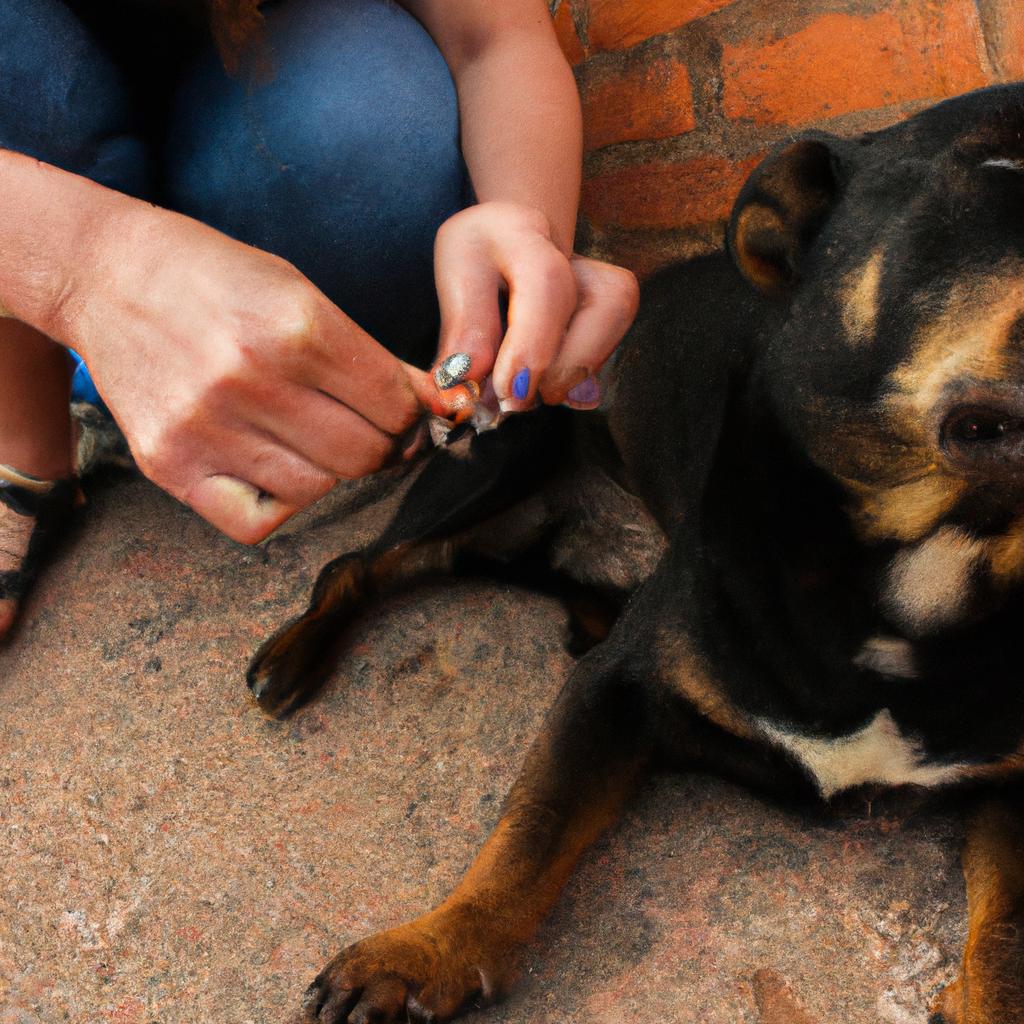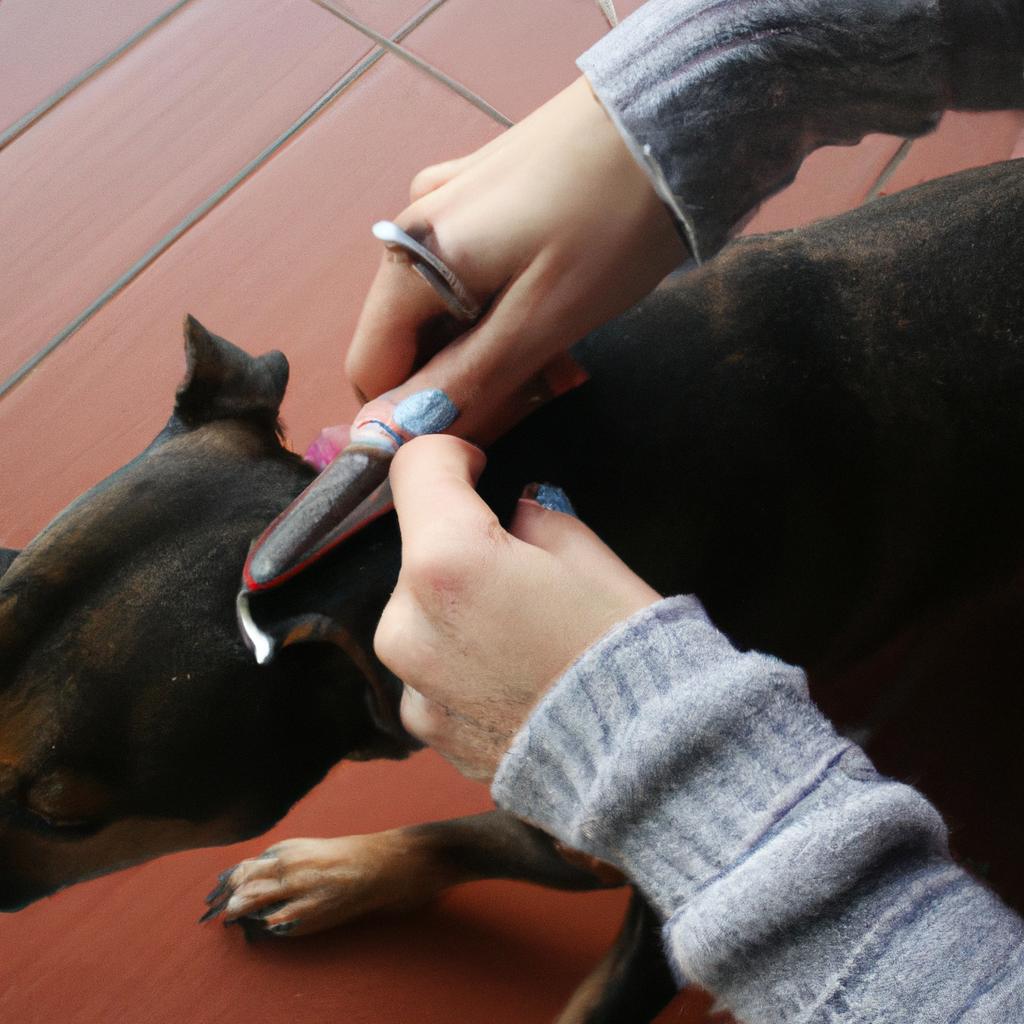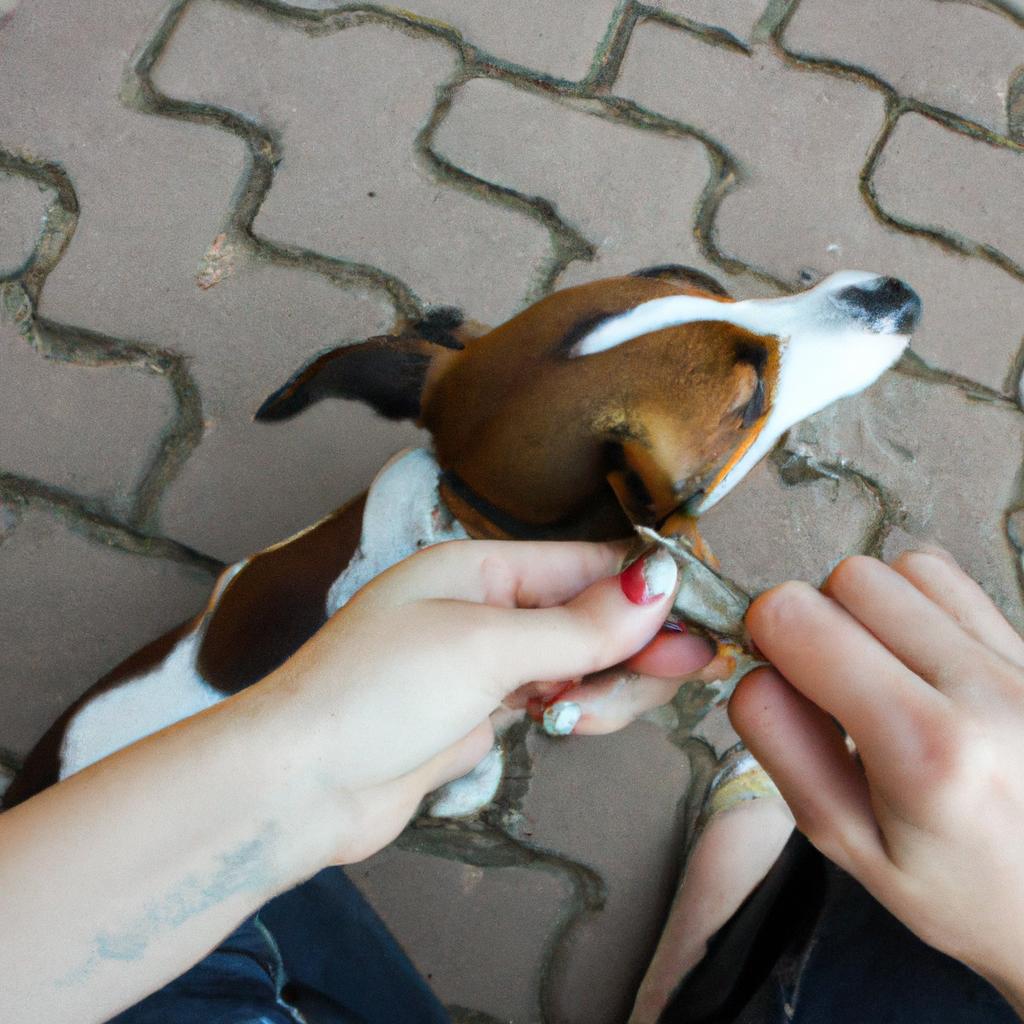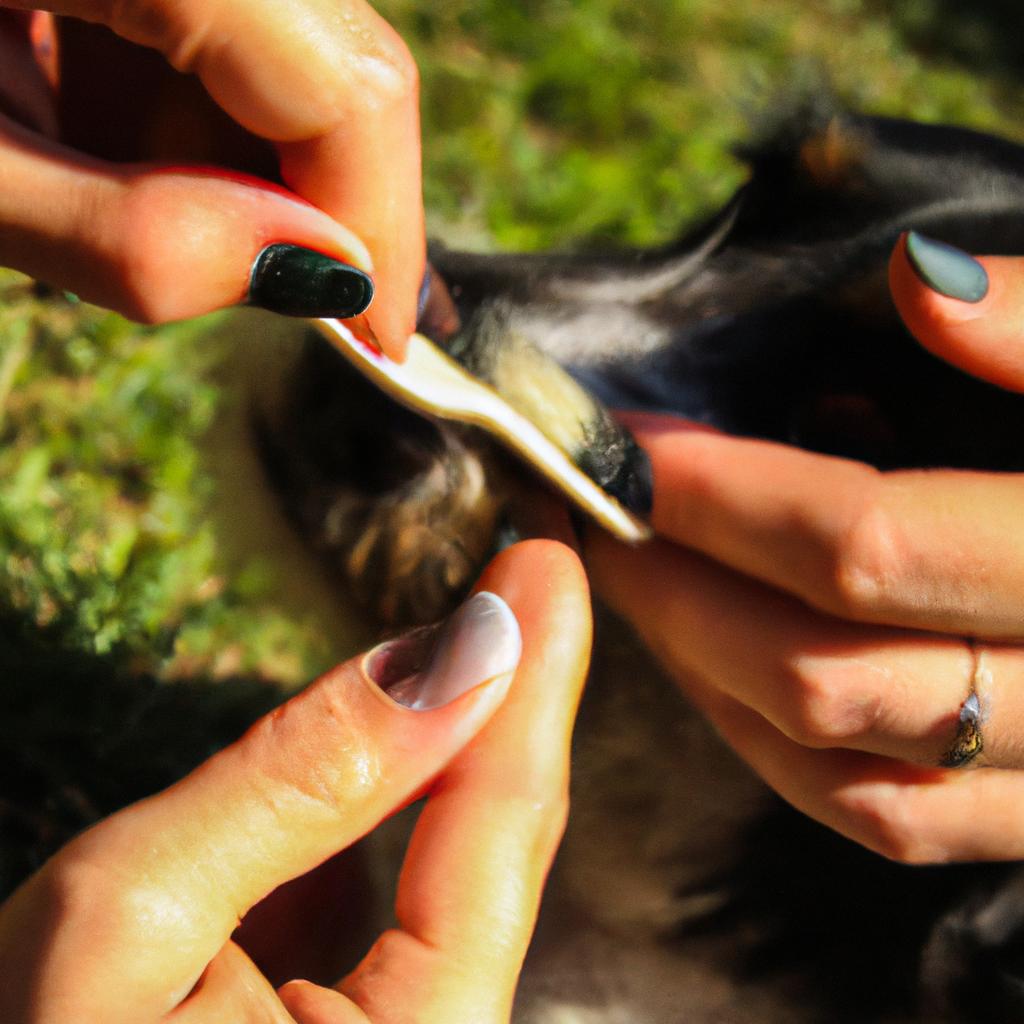Sanitary Trim: Nail Trimming in Dog Grooming Salon

In the world of dog grooming, one essential task is nail trimming. This procedure not only maintains a dog’s hygiene but also prevents potential health issues and discomfort for both the pet and its owner. A particular type of nail trim known as the “sanitary trim” focuses on removing excess hair around the paw area to ensure cleanliness and prevent matting or tangling. For instance, in a recent case study, a poodle named Bella experienced frequent infections due to accumulated dirt and moisture between her long fur and nails. Through regular sanitary trims at a professional dog grooming salon, Bella’s overall well-being improved significantly.
Nail trimming can be challenging for pet owners who lack experience or have dogs that are resistant to this process. Consequently, seeking assistance from professional groomers becomes imperative. Dog grooming salons specializing in sanitary trims offer expert knowledge and precision techniques to address specific concerns related to excessive hair growth around the paws. By carefully removing this excess hair, groomers not only promote hygiene but also enhance comfort for furry companions during physical activities such as walking or running. Moreover, maintaining proper sanitation through these trims minimizes risks associated with bacterial infections caused by trapped debris within thick fur layers.
To summarize, sanitry trims play a vital role in maintaining a dog’s overall hygiene and preventing potential health issues caused by excessive hair growth around the paws. By removing this excess hair, professional groomers ensure cleanliness, prevent matting or tangling, and minimize the risk of bacterial infections. Regular sanitary trims not only enhance a dog’s comfort during physical activities but also contribute to their overall well-being.
Why Sanitary Trim is Important
Imagine a scenario where you bring your beloved furry friend to the dog grooming salon for their regular nail trimming appointment. The groomer, with diligence and care, not only trims the nails but also performs a sanitary trim. This additional step may seem small or inconsequential at first glance, but it plays a crucial role in maintaining your pet’s health and overall wellbeing.
Importance of Sanitary Trim:
A sanitary trim focuses on removing excess hair from around your dog’s genital area and hindquarters. By doing so, it helps prevent various hygiene-related issues that can arise if left unattended. One such example is fecal matter becoming entangled in long fur, leading to discomfort and potential infections. Additionally, excessive hair growth in these areas can create an ideal environment for bacteria and parasites to thrive, further compromising your pet’s health.
To emphasize the significance of performing a sanitary trim regularly, consider the following bullet points:
- Improved cleanliness: A trimmed coat reduces the likelihood of dirt, debris, or urine getting trapped in long hair.
- Enhanced comfort: Removing excess hair prevents matting and tangling around sensitive areas like genitals and hindquarters.
- Reduced risk of infection: Trimming limits bacterial growth by minimizing moisture retention caused by prolonged contact between fur and bodily fluids.
- Prevention of skin irritations: Maintaining proper hygiene through regular sanitary trims minimizes irritation due to trapped substances or friction against the skin.
Table – Common Issues Resulting from Lack of Sanitary Trim:
| Issue | Description | Potential Consequences |
|---|---|---|
| Fecal Matter Accumulation | Hair entrapment leads to difficulty in cleaning after bowel movements. | Risk of infections & unpleasant odor |
| Bacterial Infections | Excessive hair provides an ideal breeding ground for harmful bacteria. | Skin inflammation & persistent itchiness |
| Parasitic Infestations | Long hair serves as a haven for fleas, ticks, and other parasites. | Increased chances of disease transmission |
| Skin Irritations | Trapped substances or friction against the skin cause irritation. | Redness, rashes & discomfort |
By recognizing the importance of sanitary trim in maintaining your pet’s hygiene, comfort, and health, you can ensure their overall wellbeing. In the following section about “Steps to Perform a Sanitary Trim,” we will explore how this essential grooming procedure is carried out effectively.
Understanding why a sanitary trim is crucial paves the way for implementing proper techniques during nail trimming appointments. Now let us delve into the steps required to perform a successful sanitary trim.
Steps to Perform a Sanitary Trim
Understanding the importance of maintaining proper hygiene in dog grooming, let us now delve into the steps involved in performing a sanitary trim. By following these guidelines, groomers can ensure that dogs receive thorough care and maintain optimal cleanliness.
Steps to Perform a Sanitary Trim:
-
Preparation:
- Before starting the sanitary trim, it is crucial to gather all necessary tools such as clippers, scissors, and styptic powder.
- Choose an appropriate area for trimming that provides enough space and comfort for both the groomer and the dog.
- Begin by gently brushing the dog’s coat to remove any tangles or mats, ensuring a smooth process during the trim.
-
Identifying the Area:
- Once prepared, identify the specific area on the dog where you will be focusing your attention. This typically includes around the genitals and anus.
- Use gentle techniques to lift and maneuver excess hair away from this area.
- Be mindful of not causing any discomfort or pain to the dog while working in sensitive areas.
-
Trimming Technique:
- It is recommended to use electric clippers with guard combs for efficiency and safety during a sanitary trim.
- Start by setting up an appropriate guard comb size based on how much hair needs to be removed.
- Carefully guide the clippers along with the contours of the body, moving gradually towards the desired length. Ensure precision while avoiding accidental cuts or nicks.
- Maintain a calm environment throughout the procedure to ease any anxiety or stress experienced by both groomer and dog.
- Regularly clean and disinfect equipment between uses to prevent cross-contamination.
- Monitor for signs of discomfort or irritation during and after trimming; seek veterinary advice if needed.
- Always prioritize safety measures such as wearing protective gloves when handling sharp tools or potentially hazardous substances like styptic powder.
Table (3 columns x 4 rows):
| Tools | Purpose | Example |
|---|---|---|
| Clippers | Trim excess hair | Professional electric clippers with guard combs |
| Scissors | Precise trimming | Rounded-tip scissors for delicate areas |
| Styptic Powder | Control bleeding | Quick-action powder to stop minor cuts or nicks |
| Protective Gloves | Ensure safety | Disposable gloves made of latex or synthetic materials |
In conclusion, performing a sanitary trim requires careful preparation, attention to detail, and adherence to safety protocols. By following these steps, groomers can ensure that dogs receive the necessary cleanliness while minimizing discomfort. Next, we will explore some common challenges faced during the process of a sanitary trim.
While mastering the steps involved in a sanitary trim is crucial, groomers often encounter various challenges along the way. Understanding and overcoming these obstacles are essential for maintaining efficient and effective grooming practices.
Common Challenges in Sanitary Trim
Now that we have discussed the steps to perform a sanitary trim, let us delve into some common challenges encountered during this process.
Imagine a scenario where a dog named Max enters a grooming salon for a sanitary trim. Max is usually calm and well-behaved, but today he seems anxious and restless. As the groomer begins the trim, Max becomes increasingly agitated, making it difficult to proceed smoothly. This situation highlights one of the many challenges that groomers may face when performing sanitary trims on dogs.
When it comes to conducting sanitary trims, there are several obstacles that can arise. Here are some common challenges:
- Anxiety or fear: Dogs may experience anxiety or fear due to unfamiliar surroundings, previous negative experiences at grooming salons, or simply because they do not enjoy being handled for extended periods.
- Restlessness or fidgeting: Some dogs find it hard to remain still during the trimming process, constantly moving around or trying to escape from the grooming table.
- Sensitivity or discomfort: Dogs with sensitive skin or those who have had previous painful encounters during nail trims might exhibit signs of distress throughout the session.
- Aggression or aggression-related behaviors: A small percentage of dogs may display aggressive behavior towards groomers due to fear, pain, territoriality, or other underlying issues.
To further understand these challenges and their potential impact on both groomers and pets alike, consider the following table:
| Challenge | Description | Emotional Response |
|---|---|---|
| Anxiety | Dogs feeling uneasy and nervous about being in an unfamiliar environment | Worry |
| Restlessness | Canine restlessness leading to difficulty in maintaining stillness during trimming | Frustration |
| Sensitivity | Sensitive skin causing discomfort and possible pain during nail trims | Concern |
| Aggression | Dogs displaying aggressive behavior towards groomers due to various reasons | Fear |
As a dog owner or groomer, it is important to address these challenges effectively. Understanding the emotions associated with each challenge can help in finding appropriate solutions and creating a more positive grooming experience for both dogs and groomers.
Looking beyond the common challenges faced during sanitary trims, let us now focus on effective techniques for handling difficult dogs in such situations.
Tips for Handling Difficult Dogs
Section: Common Challenges in Sanitary Trim
In the world of dog grooming, performing a sanitary trim can present its own set of challenges. While this procedure is essential for maintaining a dog’s hygiene and preventing discomfort or infections, groomers often encounter difficulties that require careful handling. Understanding these common challenges will enable groomers to approach each case with patience and expertise.
Example Case Study: Imagine a scenario where a timid Yorkshire Terrier named Bella visits a grooming salon for her regular sanitary trim. As soon as Bella enters the salon, she becomes anxious and starts trembling uncontrollably. Her fear escalates when she sees the nail clippers, leading her to become aggressive towards anyone who attempts to touch her paws. This situation highlights one challenge that groomers frequently face – dealing with fearful or aggressive dogs during the trimming process.
To navigate such challenges effectively, groomers should consider employing various strategies:
- Calm Approach: Groomers must maintain a calm demeanor throughout the session while speaking softly and avoiding sudden movements. Creating an atmosphere of tranquility helps alleviate anxiety in apprehensive dogs like Bella.
- Positive Reinforcement: Using treats and praise as rewards can encourage cooperative behavior from nervous dogs during their sanitary trims.
- Slow Introduction: Introducing tools gradually allows dogs to familiarize themselves with them without feeling threatened. In Bella’s case, starting by simply touching her paws gently before progressing to clipping would help build trust over time.
- Professional Restraints: When necessary, using appropriate restraints ensures both the safety of the dog and the groomer during challenging situations.
| Challenge | Strategy |
|---|---|
| Fearful Dogs | Maintain calmness and use positive reinforcement |
| Aggressive Behavior | Slowly introduce tools and utilize professional restraints |
Successfully navigating through these common challenges requires skill, patience, and understanding on behalf of dog groomers. By implementing these strategies when faced with fearful or aggressive dogs, groomers can help create a more comfortable and stress-free grooming experience for both the dog and themselves.
Transitioning into the subsequent section about “Benefits of Regular Sanitary Trimming,” it becomes evident that despite the challenges faced during this procedure, the importance of regular sanitary trims cannot be overlooked. By addressing these issues head-on, groomers contribute to maintaining the overall well-being of our furry companions.
Benefits of Regular Sanitary Trimming
Handling difficult dogs during nail trimming can be a challenging task for dog groomers. However, with the right techniques and patience, it is possible to ensure a safe and stress-free sanitary trim experience. In this section, we will explore the benefits of regular sanitary trimming for dogs and how it contributes to their overall well-being.
Benefits of Regular Sanitary Trimming:
Maintaining proper hygiene:
Regular sanitary trimming plays a crucial role in maintaining a dog’s overall hygiene. By keeping their nails at an appropriate length, potential issues such as ingrown nails or infections can be prevented. This is especially important for active dogs that spend significant time outdoors or those with long coats that may hide dirt and debris.
Enhancing mobility and comfort:
Overgrown nails can cause discomfort and affect a dog’s mobility. Long nails can alter a dog’s gait, leading to joint strain and potential injury. By regularly trimming the nails to an optimal length, dogs are able to walk comfortably without any pain or difficulty.
Preventing structural problems:
When left unaddressed, overgrown nails can lead to more serious structural problems in dogs’ paws. These include splayed toes or even deformities in the paw pads due to excessive pressure exerted on them. Regular trimming helps prevent these conditions from developing, ensuring healthy feet and strong support for your furry friend.
Promoting positive behavior modification:
Consistent nail trimming sessions create opportunities for positive reinforcement training. When done correctly using reward-based methods, dogs learn to associate nail trims with pleasant experiences rather than fear or discomfort. This not only makes subsequent grooming sessions easier but also strengthens the bond between pet owners and their beloved companions.
Emotional Impact (Bullet Point List):
- Peaceful walks without the fear of painful paw injuries.
- Improved overall well-being and comfort for your dog.
- Enhanced trust and cooperation between you and your four-legged friend.
- The satisfaction of knowing that you are providing the best care possible for your pet.
Table: Emotional Impact
| Peaceful walks without the fear of painful paw injuries |
| Improved overall well-being and comfort for your dog |
| Enhanced trust and cooperation between you and your four-legged friend |
| The satisfaction of knowing that you are providing the best care possible for your pet |
Regular sanitary trimming is an essential aspect of dog grooming, ensuring not only their physical health but also their emotional well-being. To achieve optimal results, professional groomers rely on a variety of specialized tools designed specifically for this purpose.
Professional Tools for Sanitary Trim
Section H2: Professional Tools for Sanitary Trim
Transitioning from the previous section on the benefits of regular sanitary trimming, it is crucial to understand the importance of using professional tools when performing this grooming procedure. By utilizing proper equipment and instruments specifically designed for nail trimming in dog grooming salons, groomers can ensure safe and effective results. Let’s explore some essential professional tools that are commonly used in sanitary trims.
- Case study example: Imagine a scenario where a skilled dog groomer uses high-quality professional tools during a sanitary trim session. The groomer carefully selects appropriate instruments according to each individual dog’s needs, providing a comfortable experience for both pet and owner.
When it comes to nail trimming, there are several key professional tools that facilitate accurate and efficient procedures:
-
Nail Clippers: These specialized clippers come in different sizes and styles tailored for various breeds or specific nail types. They allow precise cuts while minimizing the risk of injury to the quick (the sensitive blood vessel inside the nail).
-
Grinders: Electric grinders provide an alternative option to traditional clippers by grinding down nails instead of cutting them off. This method offers more control over nail length and reduces the likelihood of accidentally clipping too close.
-
Styptic Powder/Pencil: Accidents may happen despite precautions taken during trimming sessions. Having styptic powder or pencil readily available helps stop bleeding quickly if a pet’s nail is trimmed too short.
-
Pet-Friendly Restraint Tools: To ensure safety throughout the process, professionals use restraint tools such as harnesses or grooming loops designed with comfort in mind. These aids prevent dogs from moving excessively during sanitary trims, reducing stress levels for both pets and groomers.
Let us now consider how these professional tools contribute not only to the effectiveness but also to enhancing overall customer satisfaction within dog grooming salons:
| Benefits | Customer Satisfaction |
|---|---|
| Precise trimming | Ensures the pet’s nails are cut to an appropriate length, preventing discomfort and potential injuries. |
| Reduced injury risk | Professional tools minimize the chances of cutting into the quick, which can cause pain and bleeding in dogs. |
| Efficient procedure | Using properly designed instruments allows groomers to complete sanitary trims efficiently, reducing waiting times for customers and their pets. |
| Enhanced safety measures | Restraint tools help prevent accidents during nail trimming sessions, ensuring a safe environment for both pets and groomers alike. |
By employing these professional tools within dog grooming salons, not only can groomers offer high-quality services but they can also provide peace of mind to pet owners who entrust their beloved companions’ well-being to skilled professionals.
Incorporating professional-grade equipment is undeniably crucial for achieving optimal results during sanitary trims. Grooming salons that prioritize investing in quality tools demonstrate a commitment to delivering exceptional service while prioritizing the welfare of dogs under their care.





